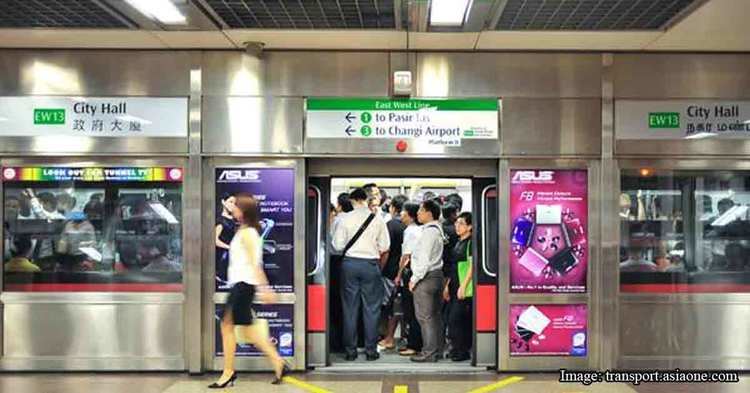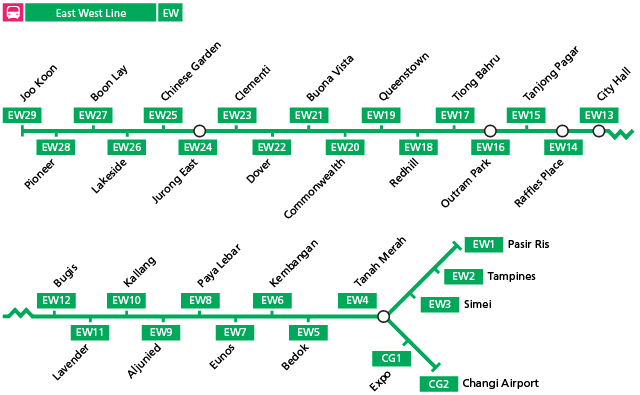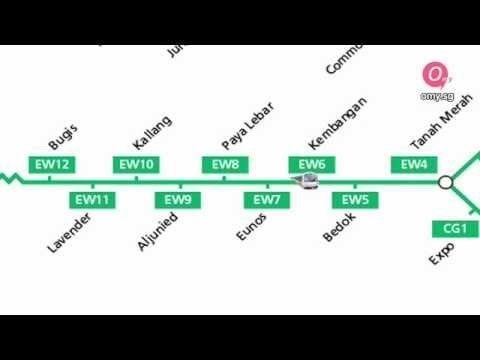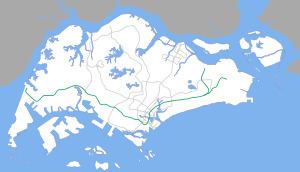Stations 31 Character Rapid transit | Services 4 | |
 | ||
Terminis Joo Koon MRT Station, Tuas Link MRT Station Depots | ||
East west mrt line
The East West Line (EWL) is the second Mass Rapid Transit line in Singapore. The line is currently 49 kilometres (30 mi) long with 35 stations, including four stations under construction and to be completed by the mid-year of 2017, known as the Tuas West Extension (TWE), making it the longest MRT line in Singapore. It currently takes about 70 minutes to travel from one end to the other (Pasir Ris to Joo Koon). The line is coloured green on MRT system maps.
Contents
- East west mrt line
- Overview
- History
- Tuas West Extension TWE
- Half height platform screen door installations
- Timeline of Stations Opened
- Timber to concrete sleeper replacement works
- Resignalling works
- Third rail replacement
- 7 July 2015 line disruption
- 22 March 2016 staff fatalities
- Stations
- Rolling stock
- Train control
- References

Overview
As its name implies, the line connects central Singapore to both eastern and western parts of the island, with an additional branch to Changi Airport from Tanah Merah, which is operated as a separate shuttle service. There is a short tunnel between Kembangan and Bedok where the line ascends into the hill at Siglap, and there is a longer tunnel due to the space limitations between Kallang and Redhill. The line passes through the centre median of roads in Tanah Merah, Bedok, Queenstown, Commonwealth, Dover and Clementi. It takes commuters to stations near schools such as Nanyang Technological University and Singapore Polytechnic and places of interest like Jurong Bird Park and Science Centre, and skirts past the three rivers (Singapore River, Rochor River and Kallang River).

Originally, East West Line had a short-working trip that terminated at Tanah Merah after peak hours, easier to clear but was a rare case from 2011 to 2013 (after that all trains were running to fixed schedules). There was a through connection to the Changi Airport before it changed to a shuttle service from 22 July 2003.
EWL is currently the only line connecting east and downtown.
History
The East West Line is the second line to be built, when the City Hall to Outram Park segment was opened on 12 December 1987, with through services to Yio Chu Kang. It was extended to Clementi on 12 March 1988 and to Lakeside on 5 November 1988. Additionally, the eastern extension to Tanah Merah was opened on 4 November 1989 (when the current name was adopted to reflect the operational split from the North South Line), and to Pasir Ris on 16 December 1989. The last station of the original system, Boon Lay opened on 6 July 1990. On 18 October 2001 Dover station was opened and then on 25 February 2002 the Expo and Changi Airport stations are opened. On 28 February 2009 the Pioneer and Joo Koon stations was officially opened to the public.
Tuas West Extension (TWE)

On 11 January 2011, the Tuas West Extension was announced. It is an extension of the East West Line from Joo Koon to Tuas Link. The stations — Gul Circle, Tuas Crescent, Tuas West Road and Tuas Link — will extend MRT connectivity to the Tuas area and is expected to serve more than 100,000 commuters daily.

When completed by the middle of 2017, the Tuas West Extension will be an extension of the East West Line from Joo Koon, consisting of a 7.5 km long twin-tracked MRT viaduct, four aboveground stations and a depot. The MRT viaduct is also integrated with part of a 4.8 km long road viaduct along Pioneer Road, which will increase the road capacity to cope with anticipated increase in traffic. A 26-hectare depot will also be built to provide stabling and maintenance facilities for the additional trains that will be bought for the extension and to cater for future expansion of the line.

On 4 May 2012, the Land Transport Authority marked the start of construction of the Tuas West Extension with a groundbreaking ceremony at the site of the future Tuas Link station.
It was later announced on 26 October 2016, that the station will be opened in the second quarter of 2017 instead, so that the station can take advantage of the new signalling system, which was being implemented in all of the NSEWL stations.
Half-height platform screen door installations
There were calls for platform screen doors to be installed at above-ground stations after several incidents in which passengers were killed or seriously injured by oncoming trains when they fell onto the railway tracks at above-ground stations. Underground stations already featured the doors since 1987. The authorities initially rejected the proposal by casting doubts over functionality and concerns about the high installation costs, but made an about-turn when the government announced plans to install half-height platform screen doors on the above-ground stations in January 2008, citing lower costs due to its becoming a more common feature worldwide. They were first installed at Jurong East and Pasir Ris stations in 2009 as trial runs. Installation of platform screen doors began at Clementi and Lakeside stations on April 2010. On 31 August 2011, the last station, Expo, began installation of half-height platform screen doors.
Timeline of Stations Opened
Timber to concrete sleeper replacement works
Timber sleepers are designed to last 15 to 25 years, and they have to be replaced when they are near the end of their lifespan, or when they show signs of significant wear and tear. The new sleepers installed will allow trains to move along the tracks smoothly and without the current speed restrictions. In order to carry out works at night when trains are not operational, train services were ended earlier on the East West Line. The work is divided into three phases: Phase 1 (Bugis - Tanah Merah), Phase 2 (Joo Koon - Jurong East, Tanah Merah - Pasir Ris) and Phase 3 (Jurong East - Outram Park). The sleepers have been replaced on 18 Feb 2017.
Resignalling works
A new signalling system, supplied by Thales, will replace the current aging signalling system on the East West Line. The new signalling system, costing $195 million, will reduce waiting times for trains during peak periods from the current 120 seconds to 100 seconds. The new system is expected to be operational by 2018. MRT trains are also progressively being retrofitted with new equipment on board to be compatible with the new signalling system.
Third-rail replacement
Replacement works on the Third rail, which provides electricity to the trains, are ongoing. A new third rail is being installed to replace the current one in use since 1987 and this will increase reliability of the electrical system.
7 July 2015 line disruption
During the evening peak hours on 7 July 2015, the NSEWL was completely shut down due to massive power trips detected. This was the worst breakdown in SMRT history and the first major breakdown for the East West Line. Investigations were completed and the cause narrowed down to damaged insulators which failed to supply power properly. For this disruption that brought inconvenience to 413,000 commuters, LTA imposed a 'record' fine of S$5.4 million on SMRT.
22 March 2016 staff fatalities
At around 11.10 am on 22 March 2016, two SMRT track-maintenance trainee staff were killed by a train approaching Pasir Ris MRT station at 60 km/h. The two employees joined SMRT in January 2016 and worked as technicians. They were part of a technical team of 15 staff led by a supervisor and were asked to go down to the tracks to investigate an alarm triggered by a possible signalling equipment fault close by Pasir Ris station. The operator said the team had permission to access the tracks, but did not coordinate with a Signal Unit in Pasir Ris station to ensure trains could not travel in the area where the team was. This incident resulted in a 2.5 hour service delay between Tanah Merah and Pasir Ris Stations, affecting at least 10,000 commuters.
Patrick Nathan, SMRT Vice-president, promised that "SMRT will review all safety protocols particularly those involving track access". SMRT chief executive Desmond Kuek apologised for the incident and said SMRT will investigate how "the [two men] got hit by the train".
On December 2 2016, SMRT was formally accused of failing to ensure that its employees complied with approved operating procedures when accessing the track, facing a fine of up to S$500,000. Teo Wee Kiat, SMRT's director of control operations, faces the same charge as SMRT. If convicted, Teo could be fined up to $200,000 and/or jailed for up to two years. Lim Say Heng, meanwhile, was yesterday charged with failing to ensure trains could not enter the track before the men accessed it. For causing death by committing a negligent act, he risks being fined or jailed for two years.
Investigations are still ongoing.
Stations
SMRT used to operate the branch sector of EW4 Tanah Merah MRT Station to CG2 Changi Airport as a through line from Boon Lay from 18 November 2001 until 22 July 2003, when it was replaced with a shuttle service. SMRT operates a through line from Joo Koon to Changi Airport only when train services are disrupted between Tanah Merah and Pasir Ris, with peak-hour trains being withdrawn at Tanah Merah.
As with the Circle and Downtown MRT Lines announced earlier, the four stations along the Tuas West Extension were open for public consultation from 16 December 2011 to 15 January 2012. The finalised station names were announced on 13 April 2012.
Rolling stock
Four batches of rolling stock are in service on the line, they are the C151s, the C651s, the C751Bs and the C151As. These trains operate from the two depots along the line, the Ulu Pandan Depot between Jurong East and Clementi, the Changi Depot near Tanah Merah and from 2016, the new Tuas Depot located near Tuas Checkpoint.
Train control
The East West Line is currently equipped with Westinghouse fixed block signalling system with Automatic train control (ATC) under Automatic train operation (ATO) GoA 2 (STO). The subsystems consist of Automatic train protection (ATP) to govern train speed, Automatic Train Supervision (ATS) to track and schedule trains and a relay interlocking system that prevents incorrect signal and track points from being set.
The current signalling system is currently phasing out and will be replaced by a new Thales SelTrac® Communications-based train control (CBTC) moving-block signalling system.
The new signalling system is expected to be operational by 2018. Trains will run with Automatic train control (ATC) under Automatic train operation (ATO) GoA 2 (STO). The subsystems consist of Automatic train protection (ATP) to govern train speed, NetTrac MT Automatic Train Supervision (ATS) to track and schedule trains and a Computer-based interlocking (CBI) system that prevents incorrect signal and track points from being set.
Automatic platform screen doors by Westinghouse were originally installed when the line opened, and Automatic Platform Screen Gates were later installed on elevated stations except for Tuas West Extensions stations, where they were manufactured by Fangda Group.
